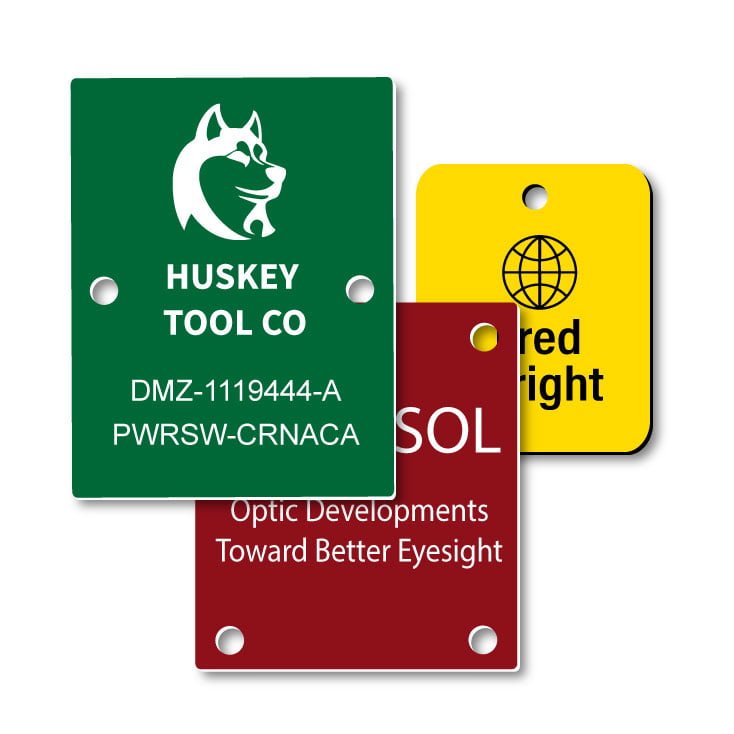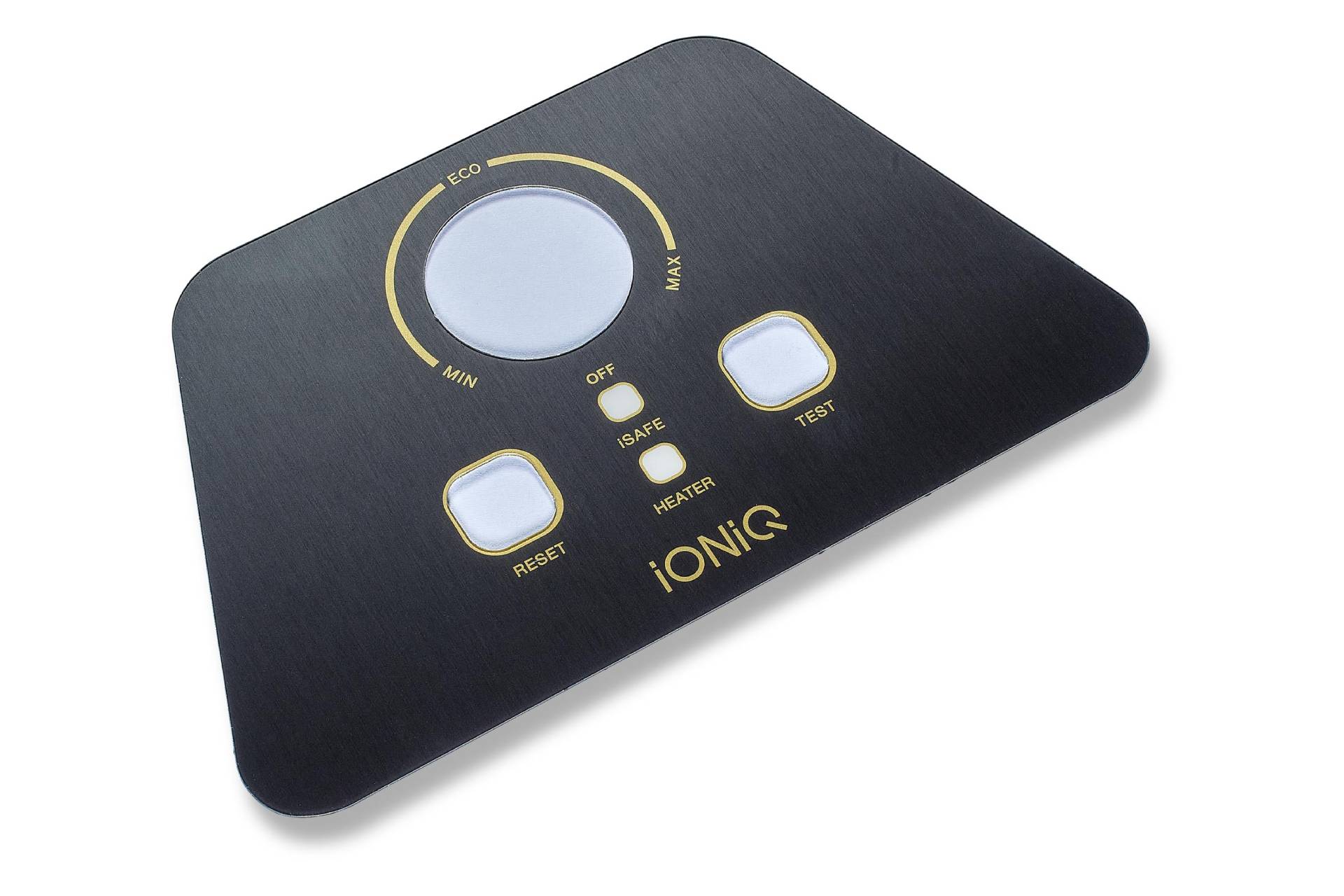How Plastic Nameplates Help Improve Facility Navigation and Signage
Recognizing Exactly How Plastic Nameplates Work: Insights Into Their Functionality and Benefits
Plastic nameplates are essential tools for identification and communication in numerous atmospheres. Built from sturdy materials like acrylic and PVC, they offer both strength and visual appeal. Various printing techniques boost their presence and branding prospective. Recognizing their capability exposes not only their functional applications however also the advantages they offer companies. As sectors evolve, the function of plastic nameplates might change, triggering a better consider their ongoing significance and innovation.
The Materials Behind Plastic Nameplates
Plastic nameplates are crafted from a selection of products, each selected for its unique homes and viability for various applications. Usual products consist of acrylic, polycarbonate, and PVC, each offering distinctive benefits. Polymer is favored for its quality and light-weight nature, making it ideal for indoor use and display purposes. Polycarbonate, understood for its high influence resistance, is often chosen for atmospheres where longevity is important (Plastic Nameplates). PVC, on the other hand, offers a cost-efficient remedy with suitable weather resistance, appropriate for outside applications.Additionally, the option of product can influence elements such as color retention, ease of printing, and overall aesthetic appeal. This selection process warranties that the end product meets specific requirements, whether for branding, recognition, or ornamental functions. Comprehending the residential properties of these products aids in making notified choices when picking plastic nameplates for numerous needs
Manufacturing Processes of Plastic Nameplates
The manufacturing processes of plastic nameplates encompass several critical steps that ensure high quality and sturdiness. Key facets consist of material selection techniques, various printing approaches, and finishing and covering choices. Comprehending these aspects is vital for producing reliable and visually pleasing nameplates.
Product Selection Strategies
Choosing the ideal materials for manufacturing plastic nameplates is important for guaranteeing toughness, aesthetic allure, and capability. Different plastic kinds are available, each offering one-of-a-kind properties suited for various applications. Polyvinyl chloride (PVC) is preferred for its price and resistance to environmental aspects, making it ideal for outdoor usage. Acrylonitrile butadiene styrene (ABS) gives boosted impact resistance and is often chosen for its premium strength and versatility. Additionally, polycarbonate is favored for applications requiring openness and high impact resistance. The selection process entails considering aspects such as the meant usage, ecological direct exposure, and wanted aesthetic top qualities. Ultimately, mindful product choice considerably affects the efficiency and durability of plastic nameplates, dealing with diverse industry demands.
Printing Methods Introduction
Material selection prepares for the subsequent printing techniques utilized in creating plastic nameplates. Different strategies, such as screen printing, digital printing, and pad printing, are employed to attain premium styles and resilient surfaces. Display printing is preferred for its capacity to create lively shades and appropriates for huge runs. Digital printing, on the various other hand, uses versatility and precision, making it optimal for smaller sized orders with variable information or detailed styles. Pad printing enables for the transfer of pictures onto uneven surfaces, accommodating complicated forms. Each printing method contributes distinctively to the last item's look and longevity, guaranteeing that the nameplates successfully convey the desired message and withstand ecological variables.
Completing and Finishing Options
Finishing and finish options play a vital role in enhancing the longevity and visual appeal of plastic nameplates. Various strategies, such as UV layer, give a safety layer that stands up to scrapes and fading, significantly prolonging the product's life-span. Additionally, laminating flooring alternatives can supply a matte or glossy coating, enabling for personalization to match branding requirements. Electroplating and anodizing are also prominent approaches, adding a metal sheen while enhancing corrosion resistance. These coatings not only boost appearance however additionally add to the nameplate's functionality by securing versus environmental elements. Specialized surfaces, such as anti-graffiti layers, assurance that nameplates keep their legibility and visual charm in difficult problems. Consequently, the right ending up and finish choices can greatly improve the total value of plastic nameplates.
Design Alternatives for Customization
While checking out layout choices for personalization, one finds a vast selection of opportunities that can boost the visual and useful charm of plastic nameplates. Shade option is a primary factor to consider, as vibrant shades can draw in focus while neutral shades advertise professionalism and trust. Different font style choices and dimensions in addition individualize nameplates, ensuring readability and positioning with brand name identity.Incorporating logos or images includes an unique touch, reinforcing organizational branding. Form customization enables for unique layouts, varying from conventional rectangles to more elaborate types, providing to details themes or environments.Textures such as matte or shiny surfaces can also affect the total appearance, providing a tactile measurement. On top of that, the assimilation of ornamental elements like boundaries or backgrounds improves aesthetic rate of interest. These modification options jointly enable companies to produce plastic nameplates that properly interact their identity and message while satisfying sensible needs.

Longevity and Long Life of Plastic Nameplates
Many elements influence the resilience of plastic nameplates, the selection of material and production procedures plays a substantial function in their long life. Premium plastics, such as polycarbonate and acrylic, are frequently picked for their integral resistance to influence, weather, and UV radiation. These materials can hold up against rough environmental problems without substantial deterioration, assuring that nameplates continue to be undamaged over time.Furthermore, advanced manufacturing strategies, such as injection molding and laser inscription, add to the toughness of plastic nameplates. These processes develop resilient and precise engravings that stand up to fading and wear. Additionally, protective layers may be used to enhance resistance to scratches and chemicals, additionally extending their lifespan.Ultimately, the mix of quality materials and reliable production procedures assures that plastic nameplates keep their functionality and appearance for years, making them a trustworthy choice for numerous applications.
Applications Across Different Industries
Plastic nameplates offer a selection of essential functions across different markets. They are typically utilized for commercial tools recognition, making certain clear labeling for safety and operational efficiency. Furthermore, they provide efficient workplace signs solutions and play a critical role in safety and security and compliance markings, highlighting their versatility and importance in diverse settings.
Industrial Devices Identification
Effective industrial equipment recognition is crucial across various fields, as it ensures security, effectiveness, and conformity with regulative requirements. Plastic nameplates act as an essential tool in this procedure, providing long lasting and clear recognition for equipment and devices. Industries such as power, production, and building make use of these nameplates to show crucial details, including running directions, hazard warnings, and upkeep schedules. Their strength to severe settings guarantees that crucial information remains easily accessible, decreasing the threat of mishaps and operational downtime. Additionally, adjustable attributes enable branding and details labeling requirements, making plastic nameplates functional throughout applications. In general, efficient equipment recognition through plastic nameplates cultivates a safer work environment while boosting efficiency in varied industrial settings.
Workplace Signs Solutions

In numerous industries, the value of clear interaction expands beyond commercial equipment to workplace atmospheres where signs plays an essential role. Plastic nameplates serve as effective office signage solutions, offering necessary details such as staff member names, work titles, and department designations. These nameplates enhance professionalism and promote a welcoming ambience, helping both team and visitors in steering the workspace. Furthermore, they provide modification options, permitting services to straighten signs with branding and visual choices. In settings like health centers, universities, and company workplaces, durable and clear signage guarantees reliable interaction and contributes to organizational efficiency. Inevitably, using plastic nameplates in office environments not just improves clarity but likewise promotes a orderly and natural office.
Security and Compliance Markings
While many companies focus on visual appeals and branding in their signage, safety and conformity markings are equally essential across various industries. These markings work as crucial devices for communication, guaranteeing that customers and staff members are mindful of potential dangers, security protocols, and regulative needs. In manufacturing, for example, plastic nameplates frequently present advising tags and use directions to minimize risks. In health care, compliance signs notifies workers about health methods and devices usage, thereby promoting a safe environment. Furthermore, the resilience of plastic nameplates makes them appropriate for numerous settings, standing up visit the website to wear and tear from ecological factors. In general, security and conformity markings enhance operational effectiveness, promote health, and warranty adherence to industry requirements, making them indispensable in modern workplaces.
Benefits of Using Plastic Nameplates
Numerous advantages helpful site make plastic nameplates an attractive option for companies and organizations. One primary benefit is their sturdiness; plastic nameplates are resistant to fading, wetness, and different environmental factors, making sure long life in varied setups. In addition, they are lightweight, making them easy to install and relocate as needed.Cost-effectiveness is one more substantial benefit. Plastic nameplates normally need lower production prices contrasted to metal or wood choices, allowing companies to keep budget plans while achieving expert branding. Their versatility likewise stands out, as they can be personalized in different shapes, sizes, and shades to match branding requirements.Furthermore, plastic nameplates can be easily printed with high-resolution designs, advertising clear exposure and effective communication. They are commonly made from recyclable materials, straightening with environmentally conscious practices. These combined advantages enhance the capability and appeal of plastic nameplates for an array of applications in different industries.

Tips for Choosing the Right Nameplate for Your Demands
Picking the best nameplate can considerably improve an organization's branding and communication initiatives. To make an educated decision, one need to initially think about the material. Plastic nameplates offer resilience and versatility, making them excellent for numerous atmospheres. Next, evaluate the layout elements, including size, color, and font design, ensuring they straighten with the company's branding guidelines.Additionally, it is important to evaluate the desired use of the nameplate. If it needs to stand up to outside conditions, selecting UV-resistant choices is a good idea. Personalization is one more vital aspect; individualized nameplates can show individuality and professionalism.Lastly, budget plan factors to consider must not be ignored. Contrasting costs across different suppliers while factoring in top quality will aid in discovering an ideal service. By taking these aspects into account, companies can pick a nameplate that efficiently connects their identification and function.
Often Asked Inquiries
Can Plastic Nameplates Be Recycled After Usage?
Plastic nameplates can be reused, depending upon the type of plastic utilized and local reusing centers. Proper disposal and recycling methods add to ecological sustainability, encouraging the decrease of plastic waste in land fills.
Exactly how Do I Tidy and Keep My Plastic Nameplate?

Are Plastic Nameplates Waterproof or Water-Resistant?
Plastic nameplates commonly display waterproof residential properties, shielding them from minor dampness direct exposure. However, long term submersion or severe conditions might jeopardize their honesty. Plastic Nameplates. Individuals should consider certain materials and finishings for boosted waterproof capabilities when selecting nameplates
What Is the Typical Lifespan of a Plastic Nameplate?
The average lifespan of a plastic nameplate generally varies from five to ten years, relying on elements such as ecological exposure, material quality, and upkeep. Routine care can expand its usability and appearance significantly.
Can I Order a Nameplate in a Certain Shape?
Customized shape options for nameplates are often readily available through different producers. Customers can request particular designs, guaranteeing that the nameplate meets their practical and aesthetic demands while keeping durability and top quality throughout its life-span. Material selection lays the groundwork for the subsequent printing approaches made use of in generating plastic nameplates. Numerous factors influence the resilience of plastic nameplates, the choice of product and manufacturing procedures plays a considerable function in their longevity. These products can stand up to severe ecological conditions without substantial deterioration, guaranteeing that nameplates stay intact over time.Furthermore, progressed manufacturing methods, such as injection molding and laser engraving, contribute to the robustness of plastic nameplates. Plastic nameplates can be recycled, depending on the type of plastic made use of and local recycling facilities. The typical life-span of a plastic nameplate typically ranges from 5 to 10 years, depending on factors such as ecological direct exposure, material top quality, and maintenance.